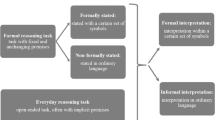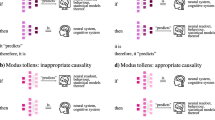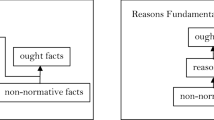Abstract
The aim of this paper is to investigate the relationship between information and abductive reasoning in the context of problem-solving, focusing on non-human animals. Two questions guide our investigation: (1) What is the relation between information and abductive reasoning in the context of human and non-human animals? (2) Do non-human animals perform discovery based on inferential processes such as abductive reasoning? In order to answer these questions, we discuss the semiotic concept of information in relation to the concept of abductive reasoning and, more specifically, to the notion of manipulative abduction proposed by Magnani (2009). Finally, we investigate a case study of corvids’ intelligence, namely, their capacity of causal cognition.

Similar content being viewed by others
Notes
We acknowledge that reality, according to Peirce, is considered more than the physical reality, encompassing the formal reality of mathematics, the fictional reality of human novels, and the potential reality of future states.
Cf. the long discussion about natural laws as counterfactual conditions, and how this is related to their dispositional aspects: “Would an ordinary match in ordinary conditions light if struck? It seems it would, but only because we presume nature to be regular in certain ways. We think this counterfactual is true because we believe there are laws. Were there no laws, it would not be the case that, if the match were struck, it would light. As a result, it would also not be the case that the match was disposed to ignite, nor the case that striking the match would cause it to light.” (Carroll 2016)
According to Anderson (1986, p. 148) “Peirce began by viewing abduction as an ‘evidencing process’ and later switched to treating it as the stage of scientific inquiry”. Despite the fact that Peirce has formulated different characterizations of the concept of abductive reasoning, these characterizations are not inconsistent, but reflect a development of Peirce’s ideas (Fann 1970). In the present paper, we discuss the concept of abductive reasoning based on the mature work of Peirce, inspired by the interpretations of Fann (1970), Anderson (1987), Magnani (2009), Paavola (2004), Campos (2011), Hintikka (1998), and Minnameier (2004).
“It must be remembered that abduction, although it is little hampered by logical rules, nevertheless is logical inference, asserting its conclusion only problematically or conjecturally, it is true, but nevertheless having a perfect logical form”. (Peirce, CP 5.188)
This picture is a print screen of the Norman video. It can be found at: <https://www.youtube.com/watch?v=CBJ28V4xGG8>.
‘Unexpected’ means that the information is “a difference that makes a difference” to the organism, cf. Bateson 1972. The Batesonian characterization helps us to understand information as a process that involves (in the context of biosemiosis) the relationship between an agent and its environment.
In the second paper, the authors also added a different modification of the solid vs. hollow test, but we do not focus on this modification in the present chapter.
It was a female crow named Kitty (Logan et al. 2014).
This is similar to questions about Umwelt, such as: “How could we have access to others’ Umwelt? In the context of Philosophy of Mind, Nagel notes: “Our own experience provides the basic material for our imagination, whose range is therefore limited. It will not help to try to imagine that one has webbing on one’s arms, which enables one to fly around at dusk and dawn catching insects in one’s mouth; that one has very poor vision, and perceives the surrounding world by a system of reflected high-frequency sound signals; and that one spends the day hanging upside down by one’s feet in an attic. In so far as I can imagine this (which is not very far), it tells me only what it would be like for me to behave as a bat behaves. But that is not the question. I want to know what it is like for a bat to be a bat. Yet if I try to imagine this, I am restricted to the resources of my own mind, and those resources are inadequate to the task. I cannot perform it either by imagining additions to my present experience, or by imagining segments gradually subtracted from it, or by imagining some combination of additions, subtractions, and modifications.” (Nagel 1974, p. 2–3)
References
Anderson, D. R. (1987). Creativity and the philosophy of C. S. Peirce. Dordrecht: Martinus Nijhoff.
Bateson, G. (1972). Steps to an ecology of mind: Collected essays in anthropology, psychiatry, evolution, and epistemology. San Francisco: Chandler Publishing Co..
Blackburn, S. (2016) (ed.). The Oxford Dictionary of Philosophy (2nd rev. ed.) Oxford: Oxford University Press. Current online version.
Campos, D. (2011) On the distinction between Peirce’s abduction and Lipton’s inference to the best explanation. Synthese, v. 180, p. 419–442.
Carroll, J. W. (2016). Laws of nature. In: Zalta E. N. (ed.) The Stanford Encyclopedia of Philosophy (Fall 2016 Edition), URL = http://plato.stanford.edu/archives/fall2016/entries/laws-of-nature/
El-Hani, C. N., Queiroz, J., Emmeche, C. (2009) Genes, Information, and Semiosis. Tartu Semiotics Library 8. Tartu: Tartu University Press.
Fann, K. T. (1970). Peirce's theory of abduction. Martinus Nijhoff, 1970.
Godfrey-Smith, P., & Sterelny, K. (2016). Biological information. In: Zalta E. N. (ed.) The Stanford Encyclopedia of Philosophy (Summer Edition), URL = http://plato.stanford.edu/archives/sum2016/entries/information-biological/.
Gonzalez, M.E.Q., Nascimento, T.C.A., Haselager, W.F.G. (2004) Informação e conhecimento: notas para uma taxonomia da informação. In: Ferreira, A., Gonzalez, M.E.Q., Coelho, J.G. (eds.), Encontros com as Ciências Cognitivas. São Paulo: Coleção Estudos Cognitivos, v. 4, p. 195–220.
Hacking, I. (1983). Representing and intervening, introductory topics in the philosophy of natural science. Cambridge: Cambridge University Press.
Hintikka, J. (1998) What is abduction? The fundamental problem of contemporary epistemology. In: Transactions of Charles S. Peirce Society. Summer. 34(3). pp. 503–533.
Hoffmeyer, J. (2008) Biosemiotics: an examination into the Signs of Life and the Life of Signs. Translated by Hoffmeyer J. and Favareau, D. Edited by Favareau, D. University of Scranton Press: Scranton and London.
Holley, A. J. (1993). Do brown hares signal to the foxes? Ethology, 94, 21–30.
Ibri, I. A. (2006). The heuristic exclusivity of abduction in Peirce's philosophy. In R. F. Leo & S. Marietti (Eds.), Semiotics and Philosophy in C. S. Peirce (pp. 89–111). Cambridge: Cambridge Scholars.
Jelbert, S. A., Taylor, A. H., Cheke, L. G., Clayton, N. S., & Gray, R. D. (2014). Using the Aesop’s fable paradigm to investigate causal understanding of water displacement by new Caledonian crows. PloS One, 9(3), e92895. doi:10.1371/journal.pone.0092895.
Logan, C. J., Jelbert, S. A., Breen, A. J., Gray, R. D., & Taylor, A. H. (2014). Modifications to the Aesop’s fable paradigm change new Caledonian crow performances. PloS One, 9(7), e103049. doi:10.1371/journal.pone.0103049.
Magnani, L. (2009). Abductive cognition: The epistemological and eco-cognitive dimensions of hypothetical reasoning. In R. Dillmann, Y. Nakamura, S. Schaal, & D. Vernon (Eds.), Cognitive systems monographs volume 3. Heidelberg: Springer.
Minnameier, G. (2004). Peirce-suit of truth – why inference to the best explanation and abduction ought not to be confused. Erkenntnis, 60, 75–105.
Nagel, T. (1974). What is it like to be a bat? The Philosophical Review, LXXXIII(4), 435–450.
Paavola, S. (2004). Abduction as a logic and methodology of discovery: The importance of strategies. Foundations of Science, 9, 267–283.
Peirce, C.S. (1958) The collected papers of Charles Sanders Peirce. Electronic edition. Vols. I-VI, Hartshorne, C., Weiss, P. (eds.), 1931-1935. Vols. VII-VIII, Burks, A.W. (ed.). Charlottesville: Intelex Corporation. Cambridge: Harvard University Press. [Quoted as CP, followed by the volume and paragraph].
Peirce, C.S. (1998) The essential Peirce: Selected philosophical writings. Vol. 2 (1893–1913). Peirce Edition Project (eds.). Bloomington & Indianapolis: Indiana University Press.
Peirce, C.S. (undated) MS 831: Reasoning and instinct. Available at: The Peirce gateway. URL: http://www.iupui.edu/~arisbe/menu/library/bycsp/ms831/ms831.htm. Accessed 15 June 2016.
Shannon, C. (1948). A mathematical theory of communication. The Bell System Technical Journal, 27(3), 379–423.
Shannon, C. E., & Weaver, W. (1949). The mathematical theory of communication. Urbana: University of Illinois Press (reprinted 1998).
Silveira, L.F.B. (2008) Informação e verdade na filosofia de Peirce. Cognitio, São Paulo, v. 9, n. 2, pp. 281–323.
Stjernfelt, F. (2014). Natural propositions. The actuality of Peirce’s doctrine of Dicisigns. Boston: Docent Press.
Uexküll, J.V. ([1940] 1982). The theory of meaning. Semiotica 42(1): 25–82.
Wilson, M. (2002). Six views of embodied cognition. Psychonomic Bulletin & Review, 9, 625–636.
Acknowledgements
This work was supported by a stipend (no. 99999.001457/2015–02) from CAPES, Brazil. We would like to thank two anonymous reviewers, Tommi Vehkavaara (editor of this special issue), Sara Marie Ehrenreich Green, Henrik Kragh Sørensen, and Maria Eunice Quilici Gonzalez for useful comments and criticism. We would also like to thank the members of our research group in History and Philosophy of Science at the Department of Science Education (UCPH), as well the members of GAEC (Academic Group of Cognitive Studies) and the attendees of the 16th Gathering of Biosemiotics, for the inspiring discussions and feedback.
Author information
Authors and Affiliations
Corresponding author
Rights and permissions
About this article
Cite this article
Vitti-Rodrigues, M., Emmeche, C. Abduction: Can Non-human Animals Make Discoveries?. Biosemiotics 10, 295–313 (2017). https://doi.org/10.1007/s12304-017-9300-0
Received:
Accepted:
Published:
Issue Date:
DOI: https://doi.org/10.1007/s12304-017-9300-0




